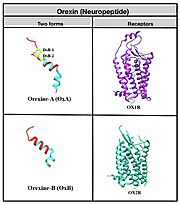User:Camryn Jiles/Sandbox 1
From Proteopedia
(Difference between revisions)
| Line 9: | Line 9: | ||
<scene name='91/910030/Neuropeptide_complex/3'>Neuropeptide penetrating the core of the neuropeptide receptor (GPCR not shown) | <scene name='91/910030/Neuropeptide_complex/3'>Neuropeptide penetrating the core of the neuropeptide receptor (GPCR not shown) | ||
</scene> | </scene> | ||
| + | == Function & Structure == | ||
Orexin's primarily play a role in the central nervous system and are responsible for arousal, wakefulness and appetite. Additionally, they are capable of various physiology functions, regulating reproductive and neuroendocrine functions, gastrointestinal motility, blood pressure, metabolism and energy balance. Orexin consists of 131 amino acids and is broken down into two forms: orexin-A (OxA) which consists of 33 amino acids and orexin-B (OxB), consisting of 28 amino acids. OxA consists of a pyroglutamyl residue on the N terminus, two disulfide bridges and an amidated C-terminus. OxB also contains an amidated C-terminus. Both proteins also contain two ɑ-helices within their structure. OxA and OxB activates orexin receptor type 1(OX1R) and orexin receptor type 2 (OXR2) that act on G protein-coupled receptors located on effector cells. It is worth noting that OX1R has a better affinity for OxA and OX2R for OxB. This signaling pathway and resulting influx of calcium into the intracellular space, is what allows orexin to mediate the various biological actions across the central and peripheral nervous system. | Orexin's primarily play a role in the central nervous system and are responsible for arousal, wakefulness and appetite. Additionally, they are capable of various physiology functions, regulating reproductive and neuroendocrine functions, gastrointestinal motility, blood pressure, metabolism and energy balance. Orexin consists of 131 amino acids and is broken down into two forms: orexin-A (OxA) which consists of 33 amino acids and orexin-B (OxB), consisting of 28 amino acids. OxA consists of a pyroglutamyl residue on the N terminus, two disulfide bridges and an amidated C-terminus. OxB also contains an amidated C-terminus. Both proteins also contain two ɑ-helices within their structure. OxA and OxB activates orexin receptor type 1(OX1R) and orexin receptor type 2 (OXR2) that act on G protein-coupled receptors located on effector cells. It is worth noting that OX1R has a better affinity for OxA and OX2R for OxB. This signaling pathway and resulting influx of calcium into the intracellular space, is what allows orexin to mediate the various biological actions across the central and peripheral nervous system. | ||
[[Image:IMG_2893.jpg | thumb]] | [[Image:IMG_2893.jpg | thumb]] | ||
| - | == Function & Structure == | ||
| - | |||
== Relevance == | == Relevance == | ||
| - | |||
| - | |||
== Inhibition == | == Inhibition == | ||
Revision as of 17:17, 25 April 2022
Neuropeptide: Orexin
| |||||||||||
References
- ↑ Hanson, R. M., Prilusky, J., Renjian, Z., Nakane, T. and Sussman, J. L. (2013), JSmol and the Next-Generation Web-Based Representation of 3D Molecular Structure as Applied to Proteopedia. Isr. J. Chem., 53:207-216. doi:http://dx.doi.org/10.1002/ijch.201300024
- ↑ Herraez A. Biomolecules in the computer: Jmol to the rescue. Biochem Mol Biol Educ. 2006 Jul;34(4):255-61. doi: 10.1002/bmb.2006.494034042644. PMID:21638687 doi:10.1002/bmb.2006.494034042644

